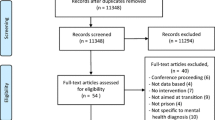Abstract
In the United States, jail frequently disrupts access to HIV care. EnhanceLink, a 10-site demonstration project promoting linkage to HIV primary care upon jail discharge, offered an opportunity to gauge how many releasees had favorable clinical outcomes. Individual level data were available on 1270 participants. Persons never discharged from the correctional environment were excluded. Multivariate logistic regression identified factors associated with viral suppression 6 months post discharge (6M-VL < 400). Among 1082 individuals eligible for follow-up evaluation, 25.7 % had 6M-VL < 400. 6M-VL < 400 was associated with case managers assessing whether help was needed for linkage to HIV-related medical services and clients keeping an appointment with a case manager. The adjusted odds ratio (aOR) of 6M-VL < 400 associated with attending a meeting with an HIV care provider within 30 days of release was 1.85. The results of this non-controlled, observational study support further development and rigorous evaluation of transitional care programs for HIV-positive jailed persons across the country.

Similar content being viewed by others
References
Spaulding AC, Seals RM, Page MJ, Brzozowski AK, Rhodes W, Hammett TM. HIV/AIDS among inmates of, and releasees from, US correctional facilities, 2006: declining share of epidemic but persistent public health opportunity. PLoS ONE. 2006;4(11):e7558. doi:10.1371/journal.pone.0007558.
Pai NP, Estes M, Moodie EE, Reingold AL, Tulsky JP. The impact of antiretroviral therapy in a cohort of HIV infected patients going in and out of the San Francisco county jail. PLoS ONE [Electronic Resource]. 2009;4(9).
Milloy MJ, Kerr T, Buxton J, et al. Dose-response effect of incarceration events on nonadherence to HIV antiretroviral therapy among injection drug users. J Infect Dis. 2011;203(9):1215–21.
Westergaard RP, Kirk GD, Richesson DR, Galai N, Mehta SH. Incarceration predicts virologic failure for HIV-infected injection drug users receiving antiretroviral therapy. Clin Infect Dis. 2011;53(7):725–31.
El-Sadr WM, Lundgren JD, Neaton JD, et al. CD4+ count-guided interruption of antiretroviral treatment. N Engl J Med. 2006;355(22):2283–96.
Cohen MS, Chen YQ, McCauley M, et al. Prevention of HIV-1 infection with early antiretroviral therapy. N Engl J Med. 2011;365(6):493–505.
Gardner EM, McLees MP, Steiner JF, Del Rio C, Burman WJ. The spectrum of engagement in HIV care and its relevance to test-and-treat strategies for prevention of HIV infection. [Review]. Clin Infect Dis. 2011;52(6):793–800.
National HIV/AIDS Strategy for the United States. July 2010. Available: http://www.whitehouse.gov/sites/default/files/uploads/NHAS.pdf. Accessed 3 Dec 2010.
Draine J, Ahuja D, Altice FL, et al. Strategies to enhance linkages between care for HIV/AIDS in jail and community settings. AIDS Care. 2011;23(3):366–77.
Addiction Severity Index, Fifth Edition 1998. Available at http://www.tresearch.org/resources/instruments/ASI_5th_Ed.pdf. Last accessed 3 June 2008.
Ware JEJP, Kosinski MM, Keller SDP. A 12-item short-form health survey: construction of scales and preliminary tests of reliability and validity. Med Care. 1996;34(3):220–33.
McGahan PL, Griffin JA, Parente R, McLellan AT. Addiction Severity Index: Composite Score Manual. Available: http://www.tresearch.org/resources/compscores/CompositeManual.pdf. Accessed 19 Dec 2011.
McLellan AT, Luborsky L, O’Brien CP, Woody GE. An improved diagnostic instrument for substance abuse patients: the Addiction Severity Index. J Nervous Mental Dis. 1980;168:26–33.
Rikoon SH, Cacciola JS, Carise D, Alterman AI, McLellan AT. Predicting DSM-IV dependence diagnoses from Addiction Severity Index composite scores. J Subst Abuse Treat. 2006;31(1):17–24.
Cacciola J, Pecoraro A, Alterman A. Development of ASI Psychiatric Severity Cut-Off Scores to identify co-occurring psychiatric disorders. Int J Mental Health Addict. 2008;6(1):77–92.
Puskas C, Forrest J, Parashar S, et al. Women and vulnerability to HAART non-adherence: a literature review of treatment adherence by gender from 2000 to 2011. Curr HIV/AIDS Rep. 2011;8(4):277–87.
Connell RW. Gender and Power. Stanford CA: Stanford University Press; 1987.
Barclay TR, Hinkin CH, Castellon SA, et al. Age-associated predictors of medication adherence in HIV-positive adults: health beliefs, self-efficacy, and neurocognitive status. Health Psychol. 2007;26(1):40–9.
Palepu A, Tyndall MW, Chan K, Wood E, Montaner JS, Hogg RS. Initiating highly active antiretroviral therapy and continuity of HIV care: the impact of incarceration and prison release on adherence and HIV treatment outcomes. Antiviral Ther. 2004;9(5):713–9.
Superak H, Spaulding A, Yang Z, et al. Cost and cost-effectiveness considerations for jail linkage services. Abstract 1902. CDC HIV Prevention Conference. Atlanta GA.
Wohl DA, Scheyett A, Golin CE, et al. Intensive case management before and after prison release is no more effective than comprehensive pre-release discharge planning in linking HIV-infected prisoners to care: a randomized trial. AIDS Behav 2011;15(2):356–64.
Acknowledgments
This study was funded under HRSA Cooperative Agreement U90HA07632, Emory Center for AIDS Research Grant P30AI050409, and a Development and Dissemination Grant from Abt Associates Inc.
Author information
Authors and Affiliations
Corresponding author
Additional information
This study is conducted on behalf of the EnhanceLink Study Group.
Electronic supplementary material
Below is the link to the electronic supplementary material.
Rights and permissions
About this article
Cite this article
Spaulding, A.C., Messina, L.C., Kim, B.I. et al. Planning for Success Predicts Virus Suppressed: Results of a Non-Controlled, Observational Study of Factors Associated with Viral Suppression Among HIV-Positive Persons Following Jail Release. AIDS Behav 17 (Suppl 2), 203–211 (2013). https://doi.org/10.1007/s10461-012-0341-8
Published:
Issue Date:
DOI: https://doi.org/10.1007/s10461-012-0341-8




